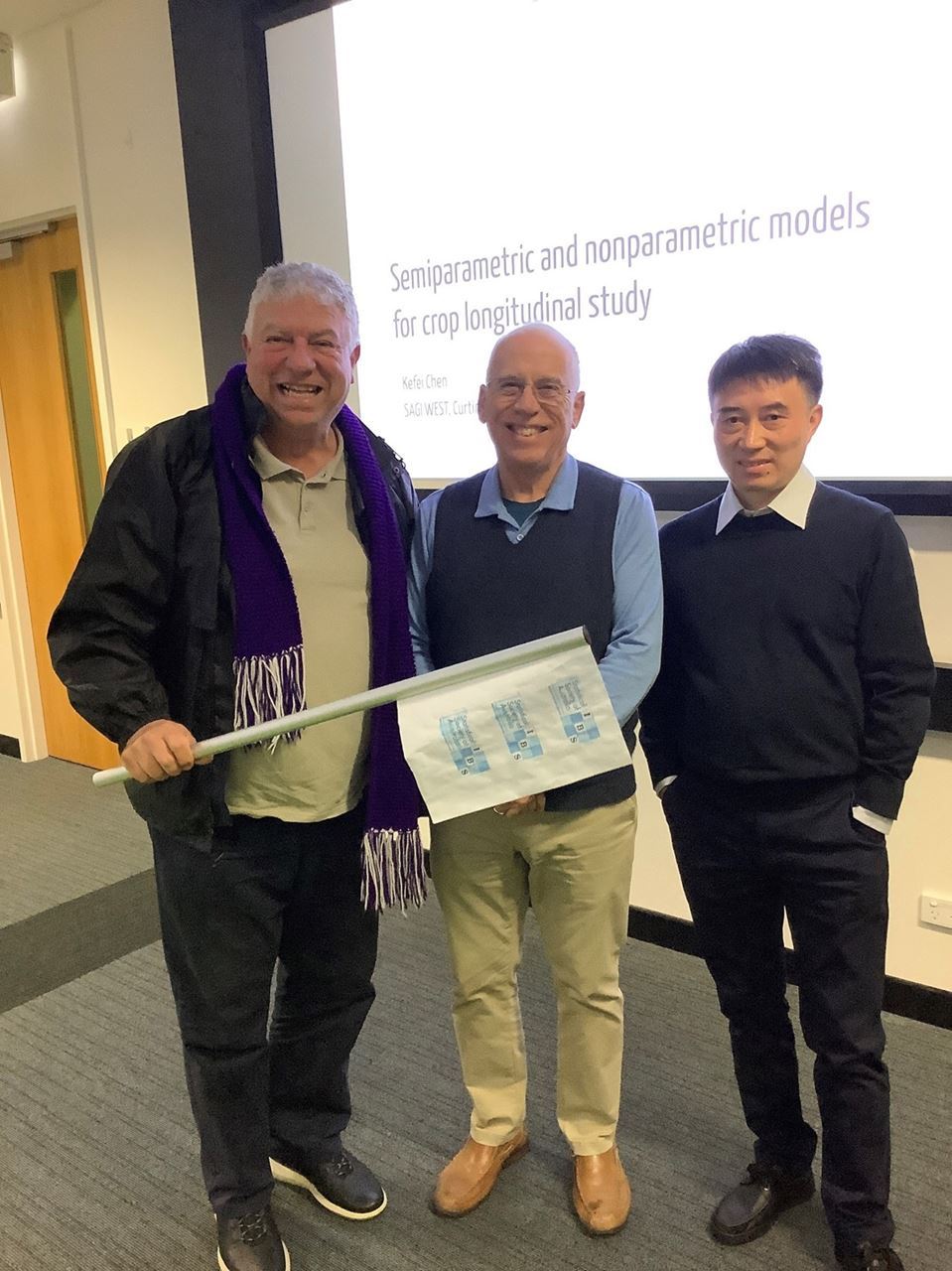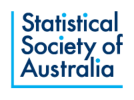WA Branch of the SSA
The August 2022 meeting of the WA Branch of the SSA was celebrated jointly with members of the International Biometric Society (IBS) led by Mario D’Antuono a former president of the Australasian Region of the IBS. This time the location of the talk was Curtin University. The speaker for the evening was Dr Kefei Chen from Statistics for the Australian Grains Industry (SAGI) West, Curtin University. Kefei spoke on “Semiparametric and nonparametric models for crop longitudinal study”. The outline of the talk began with fitting of sigmoidal curves using full parametric models a la Logistic, Log-Logistic, Gompertz & Weibull functions; semiparametric models using Generalized Additive Model (GAM) & Shape Constrained Additive Model (SCAM); Nonparametric models using Bayesian Additive Gaussian Process Model (AGPM). This was followed by symmetric or skewed Bell-shaped/ biphasic curves fitted via full parametric models using Gaussian and Log-Gaussian functions; semiparametric models using GAM & SCAM, and nonparametric models using AGPM. The final discussion covered spatio-temporal modelling for yield prediction in the WA Grainbelt using semiparametric GAM models.
 After relating formulae for parametric models he discussed motivation for full parametric regression and noted the use of R packages drc (Ritz et al., 2015) & medrc (Gerhard & Ritz, 2018). Semi-parametric regression builds on parametric regression by allowing for more flexible relationship between the predictor variables and the response variables. After a brief introduction, GAM models were fitted using the package mgcv (Wood, 2017), and SCAM models were fitted with R package scam (Pya, 2021). Finally, Bayesian Additive Gaussian Process Modelling (AGPM) was here related and fitted using R package lgpr (Timonen et al., 2021).
After relating formulae for parametric models he discussed motivation for full parametric regression and noted the use of R packages drc (Ritz et al., 2015) & medrc (Gerhard & Ritz, 2018). Semi-parametric regression builds on parametric regression by allowing for more flexible relationship between the predictor variables and the response variables. After a brief introduction, GAM models were fitted using the package mgcv (Wood, 2017), and SCAM models were fitted with R package scam (Pya, 2021). Finally, Bayesian Additive Gaussian Process Modelling (AGPM) was here related and fitted using R package lgpr (Timonen et al., 2021).
This was followed by exploratory data analysis with various plots and summary tables of fitted models illustrating comparisons. The preliminary results suggested that both semiparametric and nonparametric methods can be of great value in many applications in fields including biological and agricultural sciences and can have the advantage of flexibility with less assumptions. This is particularly so for longitudinal studies with temporal uncertainty, and unknown complex relationships
A Spatial-temporal model using GAM was then discussed where yield prediction is a key to many discussions for crop production. Wheat yield prediction in Western Australia is usually done by one of two methods, French and Schultz (F&S) (French & Schultz, 1984) and crop simulation modelling (APSIM) (McCown et al., 1996). APSIM is difficult to calibrate because of the number of parameters. The F&S approach is suggested to be too simple as it does not account for waterlogging.
Kefei and colleagues aimed to produce a simple and parsimonious but reasonably accurate model combining advantages of the F&S approach and the more complex crop simulation model, that can be used by farmers to predict wheat yield on a paddock level. Again, more plots were shown illustrating the advantages of the methodology.
The talk drew some interesting discussion, which was appreciated by all, and talks continued afterwards at a local tavern. All in all, it was a successful meeting.
Brenton R Clarke
Some references:
*Pya, N. (2021). scam: Shape Constrained Additive Models. R package version 1.2-12. URL: https://CRAN.Rproject.org/package=scam.
*Wood, S. N. (2017). Generalized additive models: an introduction with R. CRC press.
*Timonen, J., H. Mannerstrom, A. Vehtari, et al. (2021). “lgpr: an interpretable non-parametric method for inferring covariate effects from longitudinal data”. In: Bioinformatics 37.13, pp. 1860–1867.
*Ritz, C., F. Baty, J. C. Streibig, et al. (2015). “Dose-response analysis using R”. In: PloS one 10.12, p. e0146021.
*Gerhard, D. and C. Ritz (2018). medrc: Mixed effect dose-response curves. R package version 1.1-0.
*French, R. J. and J. E. Schultz (1984). “Water use efficiency of wheat in a Mediterranean-type environment. I. The relation between yield, water use and climate”. In: Australian Journal of Agricultural Research 35.6, pp. 743–764.
*McCown, R. L., G. L. Hammer, J. N. G. Hargreaves, et al. (1996). “APSIM: a novel software system for model development, model testing and simulation in agricultural systems research”. In: Agricultural systems 50.3,pp. 255–271.
